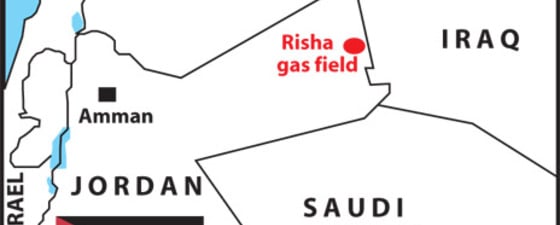Indeed, Jordan spends one-fifth of its gross domestic product to import 96% of its energy needs predominantly from Iraq (Jordan Times, 26 October 2009). Against this backdrop, it is interesting to learn that recently British Petroleum (BP) signed a deal with the government of Jordan to explore and develop the natural gas resources of the Risha Basin in eastern Jordan.
According to the agreement, signed by Jordan’s premier Nader Dahabi and BP’s exploration chief Michael Day last October, in the first phase of the project, BP will explore the area totaling about 7,000 sq. km (the equivalent of a North Sea quadrant) along the Jordanian-Iraqi border for 3-4 years at a cost of $237 million. If the exploration yields successful results, BP will then invest US$8-10 billion to produce between 300-1,000 million cubic feet (mcf) per day. Currently the Risha gas field produces 21 mcf from 20 wells.
Exploration of the Risha basin began in the mid-1980s with seismic shooting (9,057 km) and exploratory drilling by Jordan’s Natural Resources Authority. Seismic images showed horst and graben structures in the Paleozoic section. The Paleozoic sediments dip and thicken eastward while the overlying Mesozoic sediments thicken toward west and dip under the Basalt Plateau. The total sedimentary thickness in the Risha basin exceeds 7,000 m. Risha-1 (3177 m total depth) and Risha-2 (3314 m) were drilled in 1984 followed by Risha-3 (4204 m) which discovered gas in Ordovician sandstones. Since then, dozens of wells have been drilled; many are dry but some wells produce gas. The Risha field delineated to be 1500 sq. km in area produces from Ordovician tight sandstone at depths of 2425-2575 m with thin beds (2-12 m each) in faulted glacio-fluvial channels. Its proven gas reserves are 180 billion cubic feet (Bcf) (equivalent of 34.2 MMbo) (Oil and Gas Journal, 2 July 2007). However, estimates of total gas reserves in the field range from 400 bcf (Jordan Times, 12 March 2000) to 2-3 Tcf (15 September 2008, quoted from Abdulelah Rousan, then director-general of Jordan’s National Petroleum Company, NPC).
If all goes well, the Jordanian government will receive 50% of the produced gas, with the other half going to BP and NPC. This will significantly boost Jordan’s natural gas and electricity production. Currently there is an electric power plant in the Risha field.
In 2000, an international consortium headed by BP negotiated with Jordan to build a gas pipeline from Jordan via Syria to Lebanon. But the proposal was suspended after the government decided to focus on further exploration of the Risha basin. In the same year, the NPC in collaboration with Geoquest (a division of Schlumberger) conducted a detailed study of the Risha gas field.
The Risha gas field is located 270 km northeast of Amman. What amplifies the importance of the Risha field is that it shares a similar geologic history with the little-developed Akkas gas field, some 200 kilometers further east in Iraq. Indeed, the Paleozoic section thickens eastward up to 6,500 m. It appears that the deserts of eastern Jordan and western Iraq have a great potential for Paleozoic tight gas plays awaiting systematic exploration.
Acknowledgements:
I thank Nicola Dahdah for helpful geologic information.





